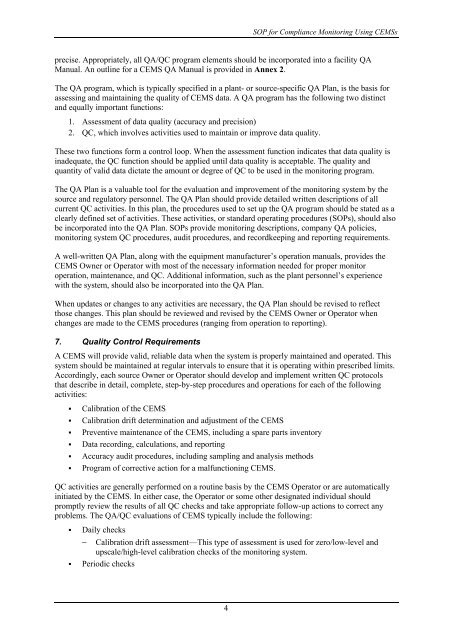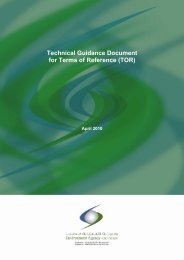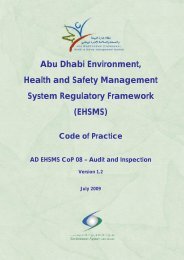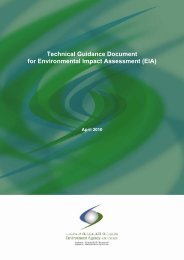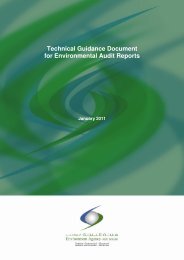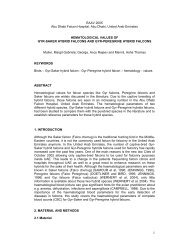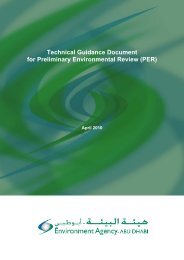Standard Operating Procedure (SOP) for Compliance Monitoring ...
Standard Operating Procedure (SOP) for Compliance Monitoring ...
Standard Operating Procedure (SOP) for Compliance Monitoring ...
Create successful ePaper yourself
Turn your PDF publications into a flip-book with our unique Google optimized e-Paper software.
<strong>SOP</strong> <strong>for</strong> <strong>Compliance</strong> <strong>Monitoring</strong> Using CEMSs<br />
precise. Appropriately, all QA/QC program elements should be incorporated into a facility QA<br />
Manual. An outline <strong>for</strong> a CEMS QA Manual is provided in Annex 2.<br />
The QA program, which is typically specified in a plant- or source-specific QA Plan, is the basis <strong>for</strong><br />
assessing and maintaining the quality of CEMS data. A QA program has the following two distinct<br />
and equally important functions:<br />
1. Assessment of data quality (accuracy and precision)<br />
2. QC, which involves activities used to maintain or improve data quality.<br />
These two functions <strong>for</strong>m a control loop. When the assessment function indicates that data quality is<br />
inadequate, the QC function should be applied until data quality is acceptable. The quality and<br />
quantity of valid data dictate the amount or degree of QC to be used in the monitoring program.<br />
The QA Plan is a valuable tool <strong>for</strong> the evaluation and improvement of the monitoring system by the<br />
source and regulatory personnel. The QA Plan should provide detailed written descriptions of all<br />
current QC activities. In this plan, the procedures used to set up the QA program should be stated as a<br />
clearly defined set of activities. These activities, or standard operating procedures (<strong>SOP</strong>s), should also<br />
be incorporated into the QA Plan. <strong>SOP</strong>s provide monitoring descriptions, company QA policies,<br />
monitoring system QC procedures, audit procedures, and recordkeeping and reporting requirements.<br />
A well-written QA Plan, along with the equipment manufacturer’s operation manuals, provides the<br />
CEMS Owner or Operator with most of the necessary in<strong>for</strong>mation needed <strong>for</strong> proper monitor<br />
operation, maintenance, and QC. Additional in<strong>for</strong>mation, such as the plant personnel’s experience<br />
with the system, should also be incorporated into the QA Plan.<br />
When updates or changes to any activities are necessary, the QA Plan should be revised to reflect<br />
those changes. This plan should be reviewed and revised by the CEMS Owner or Operator when<br />
changes are made to the CEMS procedures (ranging from operation to reporting).<br />
7. Quality Control Requirements<br />
A CEMS will provide valid, reliable data when the system is properly maintained and operated. This<br />
system should be maintained at regular intervals to ensure that it is operating within prescribed limits.<br />
Accordingly, each source Owner or Operator should develop and implement written QC protocols<br />
that describe in detail, complete, step-by-step procedures and operations <strong>for</strong> each of the following<br />
activities:<br />
• Calibration of the CEMS<br />
• Calibration drift determination and adjustment of the CEMS<br />
• Preventive maintenance of the CEMS, including a spare parts inventory<br />
• Data recording, calculations, and reporting<br />
• Accuracy audit procedures, including sampling and analysis methods<br />
• Program of corrective action <strong>for</strong> a malfunctioning CEMS.<br />
QC activities are generally per<strong>for</strong>med on a routine basis by the CEMS Operator or are automatically<br />
initiated by the CEMS. In either case, the Operator or some other designated individual should<br />
promptly review the results of all QC checks and take appropriate follow-up actions to correct any<br />
problems. The QA/QC evaluations of CEMS typically include the following:<br />
• Daily checks<br />
− Calibration drift assessment—This type of assessment is used <strong>for</strong> zero/low-level and<br />
upscale/high-level calibration checks of the monitoring system.<br />
• Periodic checks<br />
4


